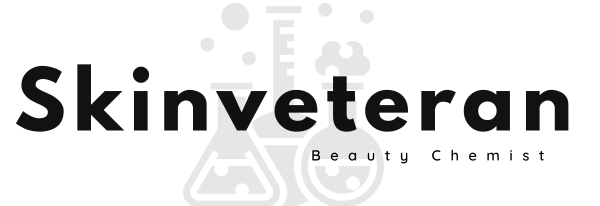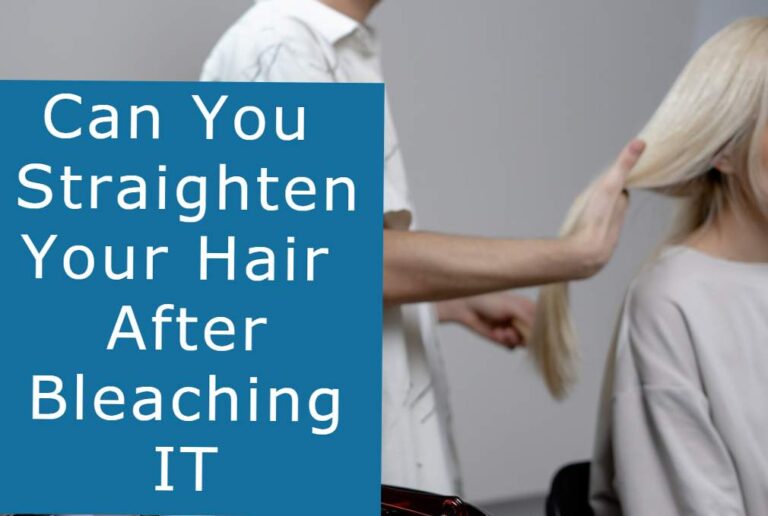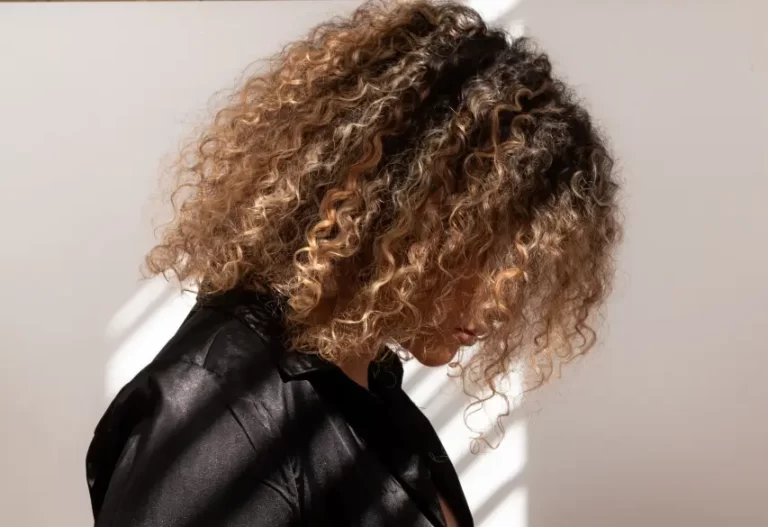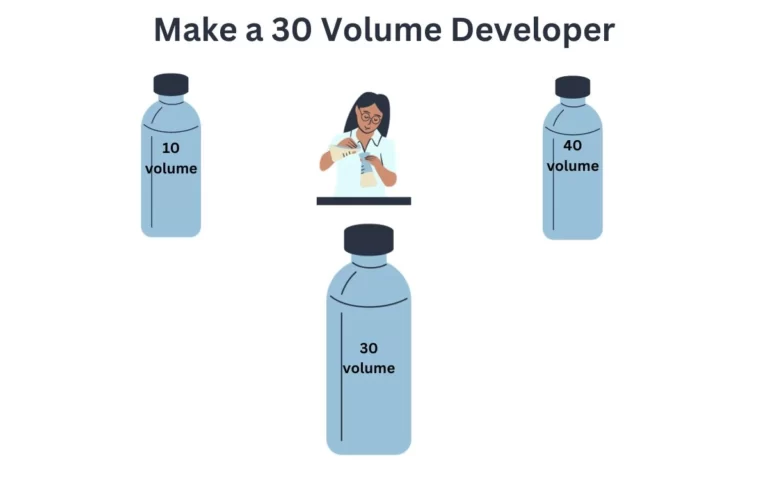The Least Damaging Hair Bleach Brands (Claims vs Reality)
Do you want to get a lighter hair color but worry about damage from the bleach? If you’re a stylist or do hair bleaching at home, you might have considered finding a brand that makes the least damaging hair bleach.
As a chemist who works in the Quality Control department of a cosmetic company, I want to tell you that while some bleach brands are safer as I explain later, it’s more about the process than the brand you use to avoid hair damage.
Usually, your hair will experience the exact extent of protein loss and dryness irrespective of which brand you use amongst the top 10.
However, you can compare some brands based on the points I discussed below to determine which would be safer. I have recommended some brands based on their formula and experimenting with them and visualizing hair strands under the microscope.
How Do You Choose the Least Damaging Hair Bleach Brand?
Hair bleaching powders typically contain ammonium, sodium, or potassium persulfate as the primary active ingredient.
According to the studies, reputable brands usually use 40-60% of the active ingredient in their bleach powder, while the rest comprises thickeners, silica components, and conditioning agents.
Ammonium persulfate is used in a 10-15% concentration, with the remaining 25-50% of the active ingredient covered with sodium persulfate to reduce the odor of ammonia.
These concentrations can go lower or higher depending upon what the brand claims, whether they make it fast-acting, 9-plus level lightening bleach, or the one that doesn’t lift hair color above 7 levels.
Charcoal-based hair bleach powders are a new thing claiming to cause less damage.
The degree of hair lightening, not the brand, determines bleaching damage. Pricey salon bleach can damage your hair the same way as drugstore bleach if applied recklessly versus moderately.
Whether you use Schwarzkopf, Wella, or Indola professional bleach powder with 9% developer for a 3-4 level lift, your hair will likely suffer the same damage.
There are a few exceptions, though. If you find these in bleach brands, they might reduce damage somewhat.
1. Brands that Include Hair Bond Protection & Repairing Ingredients
While most hair bleach powders follow the usual formula, some include bond repairing and protecting ingredients to reduce the damage.
You might have heard of bond-repairing formulas offered by Olaplex and Redken. What do they contain?
Olaplex formula contains Bis-Aminopropyl Diglycol Dimaleate, while Redken has citric acid and a bonding care complex.
A few bleach brands, like Schwarzkopf, directly include these bond-repairing ingredients in powder. Some provide them in separate packs like Clairol Professional Lightener.
If you find it on any professional bleach brand box, prefer them over those that don’t include bond-repairing ingredients.
2. Added Hair Conditioning Agents Like Keratin
You might have heard of keratin hair masks. What do they do?
They add keratin to your hair strands, making them more resilient and smooth. So, if you have to buy a hair-lightening powder or creme, prefer the one that claims added keratin.
Schwarzkopf, Wella Blondor, Joico Lumishine, and Pravana Nevo Intense Blonde all claims of keratin in their bleach powder.
Redken Flash Lift uses vitamin B5 to condition your hair and reduce damage.
Using bleach powder with keratin will likely reduce the protein loss from your hair.
3. Choose Arginine-based Hair Bleach Powder
Some brands are making Arginine-infused bleach powders that are gentler thanks to how arginine functions in lightening chemistry:
Low Ammonia Alternative: Arginine creates a mildly alkaline pH when mixed with the developer to activate bleach powder. It opens cuticles for lightening like ammonia.
However, arginine is less harsh, so the formula can minimize ammonia and sodium persulfate and use more of it. Arginine carbonate or hydrochloride is usually included in bleach powder.
Naturalized Conditioning: Since arginine is an amino acid naturally found in hair protein, it nurtures and improves integrity during color lift rather than overly stripping away protein from the strands.
Limits Over-Processing: Arginine stabilizes pH changes to maintain more precision during lengthy bleach procedures. This results in more controlled, even lifting with less damage from spikes/dips in alkaline pH and oxidation.
Bigen Powder Lightener and Pulp Riot Cream bleach are the brands that infuse arginine to make their product less damaging to your hair.
Which Bleach Brand Would I Recommend as Less Damaging?
While you can choose any brand based on the criteria/instructions I have mentioned above, the Schwarzkopf Blondme lightener stands out as the least damaging because of its bond care and repair properties.
Pulp Riot Cream Bleach and Redken Flash Lift Lightener are the other brands nearly as safe as Schwarzkopf.
The picture below shows hair strands treated with each of the lighteners mentioned above and a 10-volume developer. They are viewed under a compound microscope at my lab.
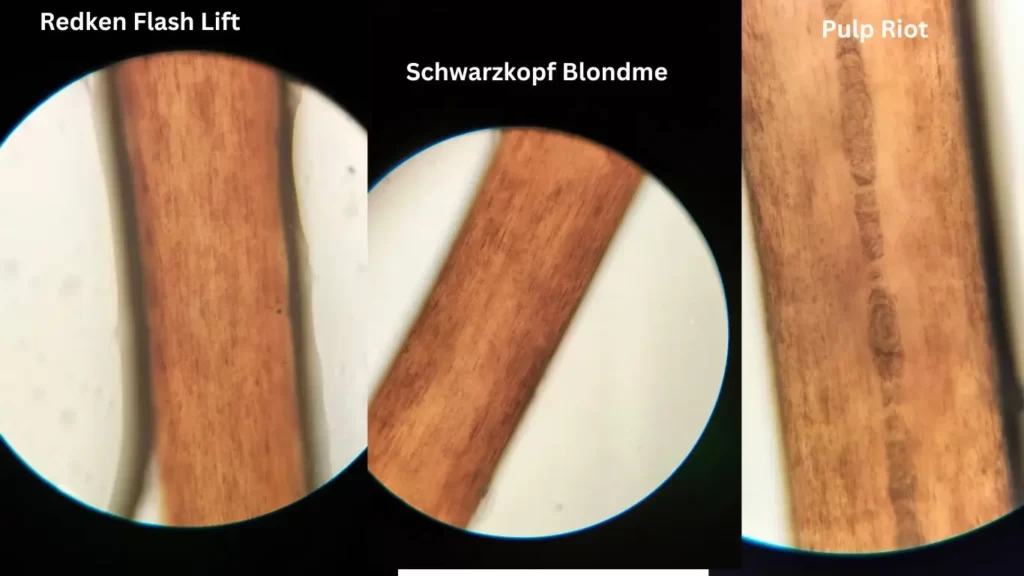
The Ultimate Recipe To Reduce Bleach Damage I Recommend
If you have little experience with doing DIY hair bleach, you need to know a few basic things to minimize the damage while pulling off excellent results.
While I am not a professional who does the procedure at the salon regularly, I do get to play around with products involved in the process at our lab.
Whatever I suggest below is purely based on what I have learnt writing about hair bleaching and perms for the past few years and my Cosmetic Lab experiments.
I also regularly get feedback from my colleagues who love to lighten their hair.
So, if you want to prevent the over-processing of your hair from Bleach, here are a few points you can consider.
Suggestion!
Always prefer a professional stylist over DIY hair bleach. They better analyze your hair condition and suggest how many levels of lift would be safer. A stylist better knows what volume developer will suit your locks. Ask them beforehand if they mix bond repairing treatment with the bleach.
1. Evaluate Your Hair Strength/Health
Finding how much protein loss your hair strands can withstand without showing visible signs of damage is critical.
Usually, people with less chemical hair styling, including bleaching, perms, and straightening, have relatively healthy hair.
Do a hair porosity test to check how much protein you have left on your locks. Higher porosity means less protein and thin, damaged hair.
In that case, you should stay under 3 levels of hair lightening.
2. Opt for Gradual Hair Color Lifting
It is always better to lift your hair gradually than in one sitting if it is above 2-3 levels, depending upon how healthy your strands are.
How does it benefit?
Your stylist will use a 20-volume developer in each session, which causes way less damage than a 30 or 40-volume.
The time window your hair gets between two sessions allows it to recover and strengthen with all the conditioning you will be doing.
3. Use Olaplex Bond Multiplier with and after bleaching
As I have explained earlier, the Olaplex formula repairs the disulfide bonds broken during aggressive bleaching action.
Several stylists, Including the famous Brad Mondo, mix the Olaplex bond multiplier with the bleach mixture to avoid hair breakage.
4. Employ Hair Conditioning Treatments after the Bleach
To bring back the shine and lustre to your manes, you need to add some of the lost protein to your hair due to aggressive bleaching.
You can use conditioning keratin hair masks or apply coconut oil regularly for that purpose.
Wrapping Up
It is always more about procedure and precaution than a bleach powder brand to reduce hair damage. However, as I recommended above, some brands are relatively safer than others. Everything, including using the proper volume developer, your hair condition, past chemical processing, bleach brand, and bond repairing treatments, have their part in reducing the damage.
